2017中考反义疑问句详解
反义疑问句用法归纳详解
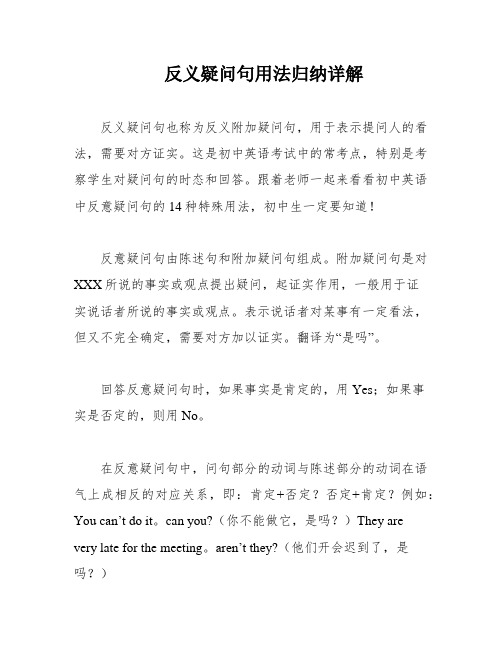
反义疑问句用法归纳详解反义疑问句也称为反义附加疑问句,用于表示提问人的看法,需要对方证实。
这是初中英语考试中的常考点,特别是考察学生对疑问句的时态和回答。
跟着老师一起来看看初中英语中反意疑问句的14种特殊用法,初中生一定要知道!反意疑问句由陈述句和附加疑问句组成。
附加疑问句是对XXX所说的事实或观点提出疑问,起证实作用,一般用于证实说话者所说的事实或观点。
表示说话者对某事有一定看法,但又不完全确定,需要对方加以证实。
翻译为“是吗”。
回答反意疑问句时,如果事实是肯定的,用Yes;如果事实是否定的,则用No。
在反意疑问句中,问句部分的动词与陈述部分的动词在语气上成相反的对应关系,即:肯定+否定?否定+肯定?例如:You can’t do it。
can you?(你不能做它,是吗?)They arevery late for the meeting。
aren’t they?(他们开会迟到了,是吗?)附加问句的主语应与陈述句的主语保持一致,且只能用人称代词替代。
例如:You come from Beijing。
don't you?(你来自北京,是不是?)当陈述句中含有be动词、助动词或情态动词时,反问句部分由这些词加上主语人称代词构成。
例如:He will go home。
won’t he?(他要回家了,是吗?)She doesn’t like to eat popcorn。
does she?(她不喜欢吃爆米花,是吗?)在使用have时,反义疑问句的动词需根据具体语境决定。
当have表“有”时,反义疑问句谓语动词可用have或do。
例如:He has a new car。
doesn’t/hasn’t he。
当have表“吃、喝、玩、度过、举办”等时,反义疑问句谓语动词需用do。
例如:He has supper at home every day。
doesn’t he?They had a great time in Beijing。
初中反义疑问句详细讲解

初中反义疑问句详细讲解反义疑问句⼀、英⽂中的反意疑问句。
1、什么是反意疑问句英语中,反意疑问句是由陈述句和附在其后的附加疑问句组成。
其中附加疑问句是对陈述句所说的事实或观点提出疑问,起证实作⽤,⼀般⽤于证实说话者所说的事实或观点。
翻译为“是吗”2.反意疑问句的回答,回答时,如果情况属实,⽤Yes加上反问句的倒装肯定句;若果情况不属实,则⽤No加上反问句的倒装否定句。
例如You were moved by your students, weren’t you?情况属实:Yes, I were.情况不属实:No, I weren’t.⼆、反意疑问句中问句部分的动词与陈述部分的动词在语⽓上成相反的对应关系,即:肯定+否定?否定+肯定?如:①You can’t do it, can you?你不能做它,是吗?②They are very late for the meeting, aren’t they?他们开会迟到了,是吗?三.当陈述句中含有be动词,助动词,或是情态动词时,反问句部分由这些词加上主语⼈称代词构成,Be动词包括:am, is, are, was, were助动词有:do, does, did, have(⽤在完成时), has(⽤在完成时)等情态动词有:can, could, may, might, must, will, would, shall, should例如:She is a lovely girl, isn’t she?她是⼀个可爱的⼥孩,是吗?He will go home, __won’t__ __he__?他要回家了,是吗?She doesn’t l ike to eat popcorn, __does__ _she___?她不喜欢吃爆⽶花,是吗?The baby won’t sleep early, will it?⼩宝宝睡得不早,是吗?注意:①He has supper at home every day,doesn’t’t he? (不能⽤hasn’t he?)他每天在家吃晚饭,是吗?②They have known the matter, haven’t they? (不能⽤don’t they?)他们已经知道那事情了,是吗?四.当陈述句中只含有⾏为动词时,若动词加了s,就⽤does, 若动词为原形,就⽤do,动词为过去式,则⽤did,例如:Your father plays the computer very well, __doesn’t__ ___he _?你⽗亲电脑技术很好,是吗?They look so happy today, _don’t ___ _they___?你今天看起来很⾼兴,是吗?五.反意疑问句的陈述部分带有little, few, never, hardly, seldom,nobody, nothing, barely, scarcely等否定意义的词时,问句部分⽤肯定式。
反义疑问句知识点
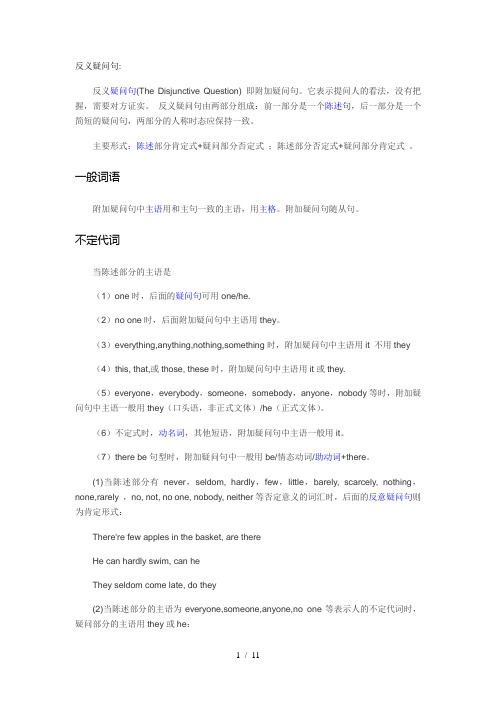
反义疑问句:反义疑问句(The Disjunctive Question) 即附加疑问句。
它表示提问人的看法,没有把握,需要对方证实。
反义疑问句由两部分组成:前一部分是一个陈述句,后一部分是一个简短的疑问句,两部分的人称时态应保持一致。
主要形式:陈述部分肯定式+疑问部分否定式;陈述部分否定式+疑问部分肯定式。
一般词语附加疑问句中主语用和主句一致的主语,用主格。
附加疑问句随从句。
不定代词当陈述部分的主语是(1)one时,后面的疑问句可用one/he.(2)no one时,后面附加疑问句中主语用they。
(3)everything,anything,nothing,something时,附加疑问句中主语用it 不用they(4)this, that,或those, these时,附加疑问句中主语用it或they.(5)everyone,everybody,someone,somebody,anyone,nobody等时,附加疑问句中主语一般用they(口头语,非正式文体)/he(正式文体)。
(6)不定式时,动名词,其他短语,附加疑问句中主语一般用it。
(7)there be句型时,附加疑问句中一般用be/情态动词/助动词+there。
(1)当陈述部分有never,seldom, hardly,few,little,barely, scarcely, nothing,none,rarely ,no, not, no one, nobody, neither等否定意义的词汇时,后面的反意疑问句则为肯定形式:There're few apples in the basket, are thereHe can hardly swim, can heThey seldom come late, do they(2)当陈述部分的主语为everyone,someone,anyone,no one等表示人的不定代词时,疑问部分的主语用they或he:Everyone in your family is a teacher, aren’t they\isn't he?(3)当陈述部分的主语为everything,something,anything.nothing等表示物的不定代词时,疑问部分的主语用it:Something is wrong with your watch, isn’t it(4)当陈述部分含有否定意思的词是unhappy,dislike,unfriendly,等含有否定词缀的派生词,也就是有un,dis,no-前缀、-less后缀等含有词缀而意思否定的词,当做肯定句处理,疑问部分要用否定形式。
中考初中反义疑问句讲解

中考初中反义疑问句讲解反意疑问句专题一、基本用法与结构反意疑问句由“陈述句+简略疑问句”两部分组成,第一部分提出一种看法,第二部分用来质疑或表示证实。
陈述部分与疑问部分的动词时态和动词性质应保持一致,而且肯定和否定形式彼此相反,即陈述部分为肯定式时,疑问部分用否定式,陈述部分为否定式时,疑问部分用肯定式:He likes English, doesn’t he? 他喜欢英语,是吗?He doesn’t like English, does he? 他不喜欢英语,是吗?【注】1. 若陈述部分含有hardly, never, few, nothing ,little,nobody,seldom等否定词或半否定词,其疑问部分要用肯定式:He has few friends here, has he? 他在这儿几乎没什么朋友,是吗?She said nothing, did she? 她什么也没说,是不是?2. 若陈述部分含有带否定前缀的词,疑问部分仍用否定式:It is unfair, isn’t it? 这不公平,不是吗?It is impossible, isn’t it? 那是不可能的,是吗?3. 当陈述部分为为there be句型时,疑问部分仍用there作“主语”:There was nothing in the room, was there? 房间里什么也没有,是吗?4. 当陈述部分的主语是指示代词(this ,that ,these ,those)时,疑问部分用it, t hey等代词:That is a new car, isn’t it? 这是一辆新汽车,是吗?5.当陈述部分的主语是复合不定代词时,若陈述部分的主语为somebody,someone, everyone, everybody, no one, nobody等复合不定代词,其反意疑问句的主语在正式文体中用he,在口语或非正式文体中通常用they:Nobody was late, were they? 没有一个人迟到,是吗?6.当陈述部分的主语是something, anything, nothing, everything等复合不定代词时,其反意疑问句的主语要用it:Everything is ready, isn’t it? 一切都准备好了吗?Nothing is important, is it? 没有什么重要的,不是吗?二、含情态动词的反意疑问句1. 基本原则:在通常情况下,当陈述部分含有情态动词时,疑问部分会重复前面同样的情态动词:He can speak English, can’t he?他会说英语,是吗?We shouldn’t go, should we? 我们不应该去,对不对?2. 当陈述部分含有must时,要分两种情况:①若must表示“必须”或“有必要”,疑问部分用mustn’t 或needn’t:You must leave at onc e, mustn’t [needn’t] you? 你必须(有必要)马上离开,是吗?但是若陈述部分有mustn’t表示禁止,疑问部分要must:You mustn’t laugh, must you? 你不准笑,知道吗?②若must表示推测,疑问部分不能用must,而应根据must后的动词结构采用相应的动词形式:He must be tired,isn’t he? 他一定累了,是吗?三、陈述部分为祈使句的反意疑问句1. 基本原则:若陈述部分为祈使句,疑问部分通常用will you:Please help us, will you? 请帮帮我们,好吗?Come with us, will you? 同我们一起去,好吗?Don’t forget to post the letter, will you? 请别忘了寄信。
(完整版)反义疑问句详细讲解及习题及答案
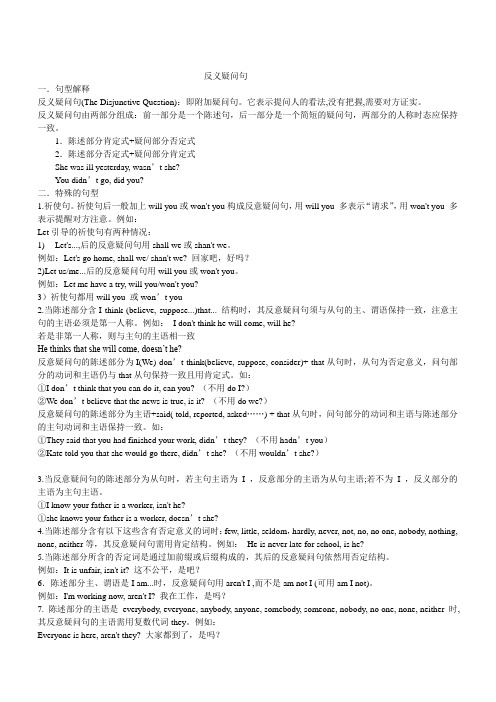
反义疑问句一.句型解释反义疑问句(The Disjunctive Question):即附加疑问句。
它表示提问人的看法,没有把握,需要对方证实。
反义疑问句由两部分组成:前一部分是一个陈述句,后一部分是一个简短的疑问句,两部分的人称时态应保持一致。
1.陈述部分肯定式+疑问部分否定式2.陈述部分否定式+疑问部分肯定式She was ill yesterday, wasn’t she?You didn’t go, did you?二.特殊的句型1.祈使句。
祈使句后一般加上will you或won't you构成反意疑问句,用will you 多表示“请求”,用won't you 多表示提醒对方注意。
例如:Let引导的祈使句有两种情况:1) Let's...,后的反意疑问句用shall we或shan't we。
例如:Let's go home, shall we/ shan't we? 回家吧,好吗?2)Let us/me...后的反意疑问句用will you或won't you。
例如:Let me have a try, will you/won't you?3)祈使句都用will you 或won’t you2.当陈述部分含I think (believe, suppose...)that... 结构时,其反意疑问句须与从句的主、谓语保持一致,注意主句的主语必须是第一人称。
例如:I don't think he will come, will he?若是非第一人称,则与主句的主语相一致He thinks that she will come, doesn’t he?反意疑问句的陈述部分为I(We) don’t think(believe, suppose, consider)+ that从句时,从句为否定意义,问句部分的动词和主语仍与that从句保持一致且用肯定式。
中考反义疑问句详解及练习和答案

反义疑问句即附加疑问句。
它表示提问人的看法,没有把握,需要对方证实。
它表示提问人的看法,没有把握,需要对方证实。
反义疑问句由两部分组成:前一部分是一个陈述句,后一部分是一个简短的疑问句,两部分的人称时态应保持一致。
1.陈述部分肯定式+疑问部分否定式2.陈述部分否定式+疑问部分肯定式They work hard, don’t they?She was ill yesterday, wasn’t she?You didn’t go, did you?He can’t ride a b ike, can he?请注意以下句型的反义疑问句的用法:1.当陈述部分的主语是I , everyone, everything, nobody 时,后面的疑问句应表示为:I am a student, aren’t IEveryone is in the classroom, aren’t they?Everything begins to grow in spring, doesn’t it?Nobody will go, will they?2. 当陈述部分有never,seldom, hardly,few,little,barely, scarcely, nothing 等否定词时,后面的疑问句则表示为:There are few apples in the basket, are there?He can hardly swim, can he?They seldom come late, do they?3. 当陈述部分是I think 加从句时,疑问句应和从句的人称时态保持一致。
I think chickens can swim, can’t th ey?I think Lucy is a good girl, isn’t she?I didn't think he was happy, was he?4. 陈述部分有had better 时,疑问句应用hadn’t开头:you’d better get up early, hadn’t you?5.当陈述部分是祈使句时,疑问句要根据语气来表达Let’s go out for a walk, shall we?Let us go our for a walk, will you?Turn on the radio, will you?6.反义疑问句的回答用yes,no,但是,当陈述部分是否定形式时,回答要按事实。
反义疑问句超详细讲解!!!
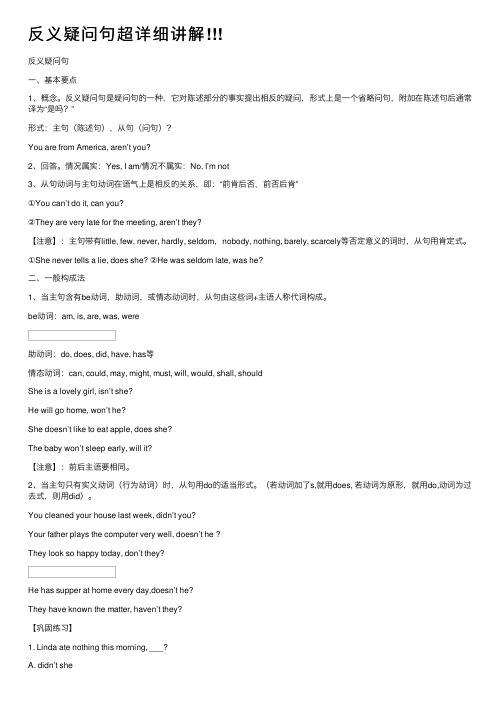
反义疑问句超详细讲解反义疑问句⼀、基本要点1、概念。
反义疑问句是疑问句的⼀种,它对陈述部分的事实提出相反的疑问,形式上是⼀个省略问句,附加在陈述句后通常译为“是吗?”形式:主句(陈述句),从句(问句)?You are from America, aren’t you?2、回答。
情况属实:Yes, I am/情况不属实:No, I’m not3、从句动词与主句动词在语⽓上是相反的关系,即:“前肯后否,前否后肯”①You can’t do it, can you?②They are very late for the meeting, aren’t they?【注意】:主句带有little, few, never, hardly, seldom,nobody, nothing, barely, scarcely等否定意义的词时,从句⽤肯定式。
①She never tells a lie, does she? ②He was seldom late, was he?⼆、⼀般构成法1、当主句含有be动词,助动词,或情态动词时,从句由这些词+主语⼈称代词构成。
be动词:am, is, are, was, were助动词:do, does, did, have, has等情态动词:can, could, may, might, must, will, would, shall, shouldShe is a lovely girl, isn’t she?He will go home, won’t he?She doesn’t like to eat apple, does she?The baby won’t sleep early, will it?【注意】:前后主语要相同。
2、当主句只有实义动词(⾏为动词)时,从句⽤do的适当形式。
(若动词加了s,就⽤does, 若动词为原形,就⽤do,动词为过去式,则⽤did)。
反义疑问句的用法归纳及回答举例初中

反义疑问句的用法归纳及回答举例初中
反义疑问句是由一个陈述句和一个反问部分组成的特殊疑问句,用于对陈述句的真实性进行确认或强调。
以下是一些反义疑问句的用法及回答的例子:
1. 陈述句 + 否定词 + 反问部分
这道题很简单,不是吗?
是的,这道题很简单。
2. 陈述句 + 反义词 + 反问部分
他是你的朋友,对吗?
不是,他不是我的朋友。
3. 陈述句 + 主语/助动词变化 + 反问部分
他去过中国,是吗?
不,他没有去过中国。
4. 陈述句 + 频率词/情态动词 + 反问部分
你经常玩电子游戏,是不是?
不,我不经常玩电子游戏。
5. 陈述句 + 动词时态/情态动词变化 + 反问部分
他会来参加聚会,不会吧?
是的,他会来参加聚会。
6. 陈述句 + 对比词 + 反问部分
苹果比橘子更好吃,不是吗?
不,我认为橘子更好吃。
7. 陈述句 + 看起来/听起来/似乎 + 反问部分
这部电影挺有趣的,不是吗?
是的,听起来很有趣。
请注意,以上例子仅供参考,具体的回答可能因为语境的不同而有所变化。
反义疑问句的用法归纳及回答举例初中
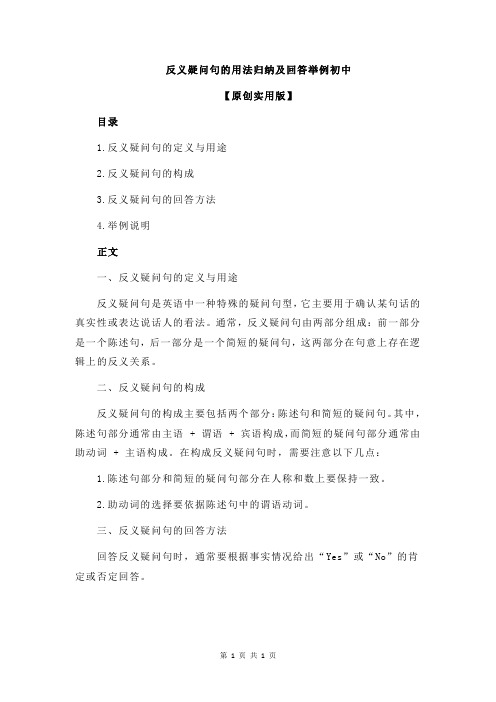
反义疑问句的用法归纳及回答举例初中
【原创实用版】
目录
1.反义疑问句的定义与用途
2.反义疑问句的构成
3.反义疑问句的回答方法
4.举例说明
正文
一、反义疑问句的定义与用途
反义疑问句是英语中一种特殊的疑问句型,它主要用于确认某句话的真实性或表达说话人的看法。
通常,反义疑问句由两部分组成:前一部分是一个陈述句,后一部分是一个简短的疑问句,这两部分在句意上存在逻辑上的反义关系。
二、反义疑问句的构成
反义疑问句的构成主要包括两个部分:陈述句和简短的疑问句。
其中,陈述句部分通常由主语 + 谓语 + 宾语构成,而简短的疑问句部分通常由助动词 + 主语构成。
在构成反义疑问句时,需要注意以下几点:
1.陈述句部分和简短的疑问句部分在人称和数上要保持一致。
2.助动词的选择要依据陈述句中的谓语动词。
三、反义疑问句的回答方法
回答反义疑问句时,通常要根据事实情况给出“Yes”或“No”的肯定或否定回答。
第1页共1页。
反义疑问句(含解析、例句及详尽用法)
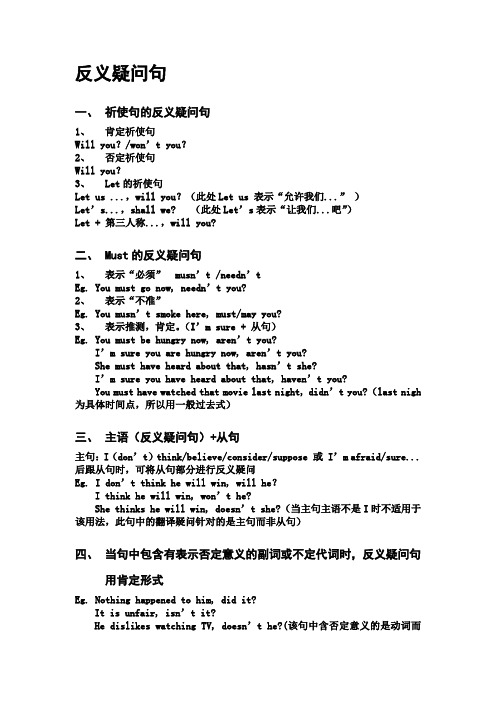
反义疑问句一、祈使句的反义疑问句1、肯定祈使句Will you?/won’t you?2、否定祈使句Will you?3、Let的祈使句Let us ...,will you?(此处Let us 表示“允许我们...”)Let’s...,shall we? (此处Let’s表示“让我们...吧”)Let + 第三人称...,will you?二、Must的反义疑问句1、表示“必须” musn’t /needn’tEg. You must go now, needn’t you?2、表示“不准”Eg. You musn’t smoke here, must/may you?3、表示推测,肯定。
(I’m sure + 从句)Eg. You must be hungry now, aren’t you?I’m sure you are hungry now, aren’t you?She must have heard about that, hasn’t she?I’m sure you have heard about that, haven’t you?You must have watched that movie last night, didn’t you?(last nigh 为具体时间点,所以用一般过去式)三、主语(反义疑问句)+从句主句:I(don’t)think/believe/consider/suppose 或 I’m afraid/sure...后跟从句时,可将从句部分进行反义疑问Eg. I don’t think he will win, will he?I think he will win, won’t he?She thinks he will win, doesn’t she?(当主句主语不是I时不适用于该用法,此句中的翻译疑问针对的是主句而非从句)四、当句中包含有表示否定意义的副词或不定代词时,反义疑问句用肯定形式Eg. Nothing happened to him, did it?It is unfair, isn’t it?He dislikes watching TV, doesn’t he?(该句中含否定意义的是动词而非副词或不定代词,因此不适用于该用法,反义疑问句仍然使用否定形式)五、反义疑问句的回答反义疑问句的回答针对被提问部分的谓语动词,且与回答句前部分的Yes和No 保持一致Eg. A: You haven’t lost the ticket, have you?B: D I know it’s hard to get another one at this moment.A. Yes, I haven’tB. No, I haveC. I hope soD. I’m afraid not六、陈述部分的主语与反义疑问句主语保持一致的情况1、OneEg. One can’t be too careful when driving a car, can one/he?一个人在开车的时候再怎么小心也不为过。
初中反义疑问句详细讲解

反义疑问句一、英文中的反意疑问句。
1、什么是反意疑问句英语中,反意疑问句是由陈述句和附在其后的附加疑问句组成。
其中附加疑问句是对陈述句所说的事实或观点提出疑问,起证实作用,一般用于证实说话者所说的事实或观点。
翻译为“是吗”2、反意疑问句的回答回答时,如果情况属实,用Yes加上反问句的倒装肯定句;若果情况不属实,则用No加上反问句的倒装否定句。
例如:You were moved by your students, weren’t you?情况属实:Yes, I were.情况不属实:No, I weren’t.二、反意疑问句中问句部分的动词与陈述部分的动词在语气上成相反的对应关系,即:肯定+否定?否定+肯定?如:You can’t do it, can you?They are very late for the meeting, aren’t they?三、当陈述句中含有be动词,助动词,或是情态动词时,反问句部分由这些词加上主语人称代词构成,Be动词:am, is, are, was, were助动词:do, does, did, have/has(用在完成时)等情态动词:can, could, may, might, must, will, would, shall, should 例如:She is a lovely girl, isn’t she?He will go home, won’t he?She doesn’t like to eat popcorn, does she?The baby won’t sleep early, will he?注意:He has supper at home every day, doesn’t he? (不能用hasn’t he?) They have known the matter, haven’t they? (不能用don’t they?)四、当陈述句中只含有行为动词时,若动词加了s,就用does, 若动词为原形,就用do,动词为过去式,则用did,例如:You cleaned your house last week, didn’t you?Your father plays the computer very well, doesn’t he?They look so happy today, don’t they?五、反意疑问句的陈述部分带有no, nothing, none, nobody,never, neither, nor, few, little, seldom, hardly等否定意义的词时,问句部分用肯定式。
初中反义疑问句详细讲解
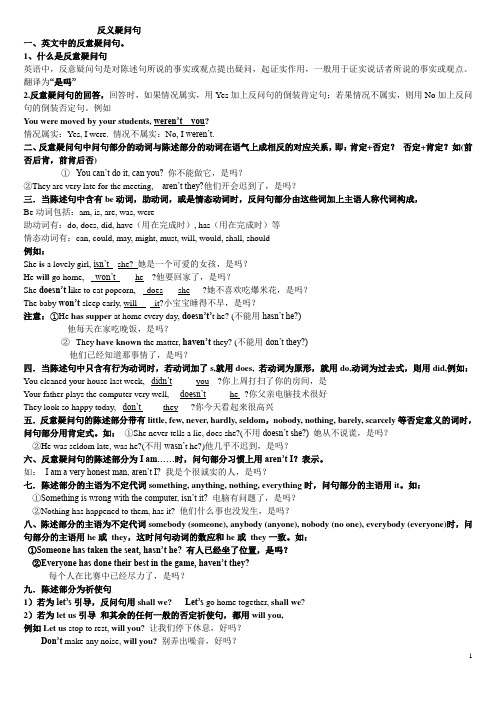
反义疑问句一、英文中的反意疑问句。
1、什么是反意疑问句英语中,反意疑问句是对陈述句所说的事实或观点提出疑问,起证实作用,一般用于证实说话者所说的事实或观点。
翻译为“是吗”2.反意疑问句的回答,回答时,如果情况属实,用Yes加上反问句的倒装肯定句;若果情况不属实,则用No加上反问句的倒装否定句。
例如You were moved by your students, weren’t you?情况属实:Yes, I were. 情况不属实:No, I weren’t.二、反意疑问句中问句部分的动词与陈述部分的动词在语气上成相反的对应关系,即:肯定+否定?否定+肯定?如(前否后肯,前肯后否)①You can’t do it, can you? 你不能做它,是吗?②They are very late for the meeting, aren’t they?他们开会迟到了,是吗?三.当陈述句中含有be动词,助动词,或是情态动词时,反问句部分由这些词加上主语人称代词构成,Be动词包括:am, is, are, was, were助动词有:do, does, did, have(用在完成时), has(用在完成时)等情态动词有:can, could, may, might, must, will, would, shall, should例如:She is a lovely girl, isn’t she? 她是一个可爱的女孩,是吗?He will go home, __won’t__ __he__?他要回家了,是吗?She doesn’t l ike to eat popcorn, __does__ _she___?她不喜欢吃爆米花,是吗?The baby won’t sleep early, will it?小宝宝睡得不早,是吗?注意:①He has supper at home every day,doesn’t’t he? (不能用hasn’t he?)他每天在家吃晚饭,是吗?②They have known the matter, haven’t they? (不能用don’t they?)他们已经知道那事情了,是吗?四.当陈述句中只含有行为动词时,若动词加了s,就用does, 若动词为原形,就用do,动词为过去式,则用did,例如:You cleaned your house last week, _didn’t___ __you__?你上周打扫了你的房间,是Your father plays the computer very well, __doesn’t__ ___he _?你父亲电脑技术很好They look so happy today, _don’t ___ _they___?你今天看起来很高兴五.反意疑问句的陈述部分带有little, few, never, hardly, seldom,nobody, nothing, barely, scarcely等否定意义的词时,问句部分用肯定式。
反义疑问句讲解

反义疑问句讲解进入高中之后,大家要学习的语法知识就更多了,反义疑问句就是大家要学习的语法之一。
在考试中大家经常会接触到这个语法,所以对于反义疑问句的掌握也是非常重要的。
今天小编就和大家一起分享该语法的讲解。
虽然说,在高中考试中,阅读题的分数占了总分数的很大一部分,但是对于语法的考察也并不少。
大家最熟悉不过的就是单项选择题了,单选题主要考察大家的就是对于各种语法和词汇的运用了。
反义疑问句就是语法考察的一个重点内容。
其实该语法涉及到的内容是非常多,不同情况下的反义疑问也是不同的,在考试中,大家也会遇到不同的情况,所以大家就要对每一种情况都非常的了解。
只有这样,才能在考试的时候做到不管从那个角度考察大家,大家都能够轻松的去做答。
首先大家要了解什么是反意疑问句,它主要是表达什么的?下面小编就和大家一起分享:陈述部分和疑问部分要么前肯后否,要么前否后肯。
这类句子有时带有感情色彩,表示惊奇,愤怒,讽刺,不服气等。
例如:You call this a day's work,don't you?你说这就叫一天的活儿,不是吗?由此大家可以看出,这类句型和它的名字一样,是表示反问别人的,带有很浓的感情色彩。
一般来说都会在选择题中考察大家,有些时候也会在完形填空中考察。
下面就是针对不同情况的反义疑问句的讲解:一、当陈述部分是祈使句时:1、肯定祈使句时,疑问部分用will you 或者won’t you..Close the door, will you / won’t you?2、否定祈使句时,只用will you.3、以let’s 开头的祈使句用shall we.4、以let us 开头的祈使句用 will you.5、以let me 开头的用 may I / will you.二、当陈述部分为并列句时,附近疑问句应采用就近原则,与最后一个分句相一致。
I help Lucy with her Chinese ,and she helps me with my English, doesn’t she?三、当陈述部分为主从复合句时:1、疑问部分须与主句保持一致:He says his mother didn’t feel well, doesn’t he?2、当陈述部分是 I think I believe I guess 等主句后跟that 从句时(主句的主语必须是I)疑问部分应和从句保持一致,并且要注意否定的转移:I believe he will pass the exam, won’t he?I don’t think he will pass the exam, will he?四、部分特殊简单句的反意疑问句:1、陈述部分是 I am 时,后面用aren’t I.2、陈述部分含有否定前、后缀构成的词时,作肯定句处理,疑问部分用否定:Tom is unhappy today, isn’t he? She is careless ,isn’t she?3、陈述部分含有never nothing hardly neither little few no nobody none too…to… no one等表示否定意义的词时,疑问部分用肯定形式:She has no money to pay for it, does she ?4、以there 开头的陈述句有两种情况:(1)、there be 句型时,疑问部分的主语用there,There are some books on the table, aren’t there?( 2)、当以表示“地点”的there 引导时,要用陈述句真实主语的相应代词形式作疑问部分的主语,常有这两个句型:There live…… There stand……There stand two trees on the hill, do n’t they? There lived a poor old man in the woods, didn’t he?5、陈述部分出现had better 句式时,后面仍用had 构成疑问部分。
反义疑问句的用法归纳及回答

反义疑问句的用法归纳及回答【反义疑问句】(一)概念:反意疑问句是由陈述句和附在其后的附加疑问句组成。
其中附加疑问句是对陈述句所说的事实或观点提出疑问,起证实作用,一般用于证实说话者所说的事实或观点。
(二)要点注意:1、反意疑问句前后两部分谓语应是:“肯定陈述+否定疑问”或“否定陈述+肯定疑问”。
2、简略问句如果是否定式:not应与be,do,will等系动词、助动词、情态动词缩写。
3、简略问句的主语不用名词,应用人称代词。
4、陈述部分含“too...to”时,是否定句。
(三)用法:1) 陈述部分I am时,疑问部分要用aren't I.I'm as tall as your sister,aren't I?(我和你姐姐一样高,对吗?)2) 陈述部分用no, nothing, nobody, never, few, little, seldom, hardly等否定含义的词时,疑问部分用肯定含义。
如:The old man made no answer, did he?Jim is never late for school, is he?3) 陈述部分有情态动词have to +v. (had to + v.),疑问部分常用don't +主语(didn't +主语)。
We have to get there at eight tomorrow, don't we?used to,疑问部分用didn't +主语或usedn't +主语。
He used to take pictures there, didn't he? / usedn't he?had better(最好)+ v. 疑问句部分用hadn't you?You'd better read it by yourself, hadn't you?4) 陈述部分有would rather(宁可、宁愿)+v.,疑问部分多用wouldn't +主语。
反义疑问句讲解
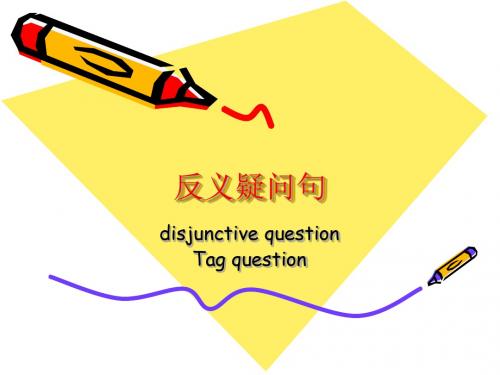
Addressing Envelopes
• (1)收信人的地址; (2)寄信人的地址; (3)邮票; (4)地址与信封上边缘留空约40mm; (5)邮寄指示<如 By Air Mail>; (6)特别注意事项,要加底线 <如 Printed Matters, Confidential>
•
sample
whish
• 陈述部分谓语动词是wish时,疑问部分 的谓语用may,而且前后两个部分都用肯 定形式
• I wish to visit the park tomorrow, may I?
• 我希望明天去公园玩,可以吗?
Used to
• 陈述部分谓语为used to 时,疑问部分 有两种形式:
• She used to go to bed at eight o’clock in the evening, didn’t she?
• She used to go to bed at eight o’clock in the evening, usedn’t she?
• 前者较常用
情态动词
像can/will等情态动词,变为否定为can’t/won’t即可
当have 在完成时中或“You had better”中时,也当情态动词变。 Have/haven’t,had/hadn’t
亨利•布朗 先生收悉
美国纽约皇后大街132 10077
比尔•威尔士
Do it yourself
• Bill Wells • 132 Queen Street • New York, 10077 • USA
•
Mr. Henry Brown
•
Chinese Import and Export Corporation
- 1、下载文档前请自行甄别文档内容的完整性,平台不提供额外的编辑、内容补充、找答案等附加服务。
- 2、"仅部分预览"的文档,不可在线预览部分如存在完整性等问题,可反馈申请退款(可完整预览的文档不适用该条件!)。
- 3、如文档侵犯您的权益,请联系客服反馈,我们会尽快为您处理(人工客服工作时间:9:00-18:30)。
四、 反意疑问句的陈述部分含有由un-, im-, in-, dis-, 等否定意义的前缀构成的词语时,陈述部分 要视为肯定含义,问句部分用否定形式。如: ①Your father is unhappy, isn’t he?(不能用is he?) ②The man is dishonest, isn’t he? (不能用is he?) ③It is impossible to learn English without remembering more words, isn’t it?(不能用is it ?)
十七、陈述部分的主语为动名词或不定 式时,问句的主语用it代替。如: ①To do one good deed is easy for a person, isn't it? ②Skating is your favorite sport, isn't it?
十三、陈述部分用had better +原形动词表示建 议时,问句部分用hadn’t +主语?形式。 ①You’d better tell him about the matter, hadn’t you? ②We had better do it by ourselves, hadn’t we?
十四、陈述部分用used to +主语时,问句部分用 didn’t + 主语?或usedn’t +主语?形式。 ①He used to live in the country, didn’t he?/usedn’t he? ②They used to be good friends, didn’t they?/usedn’t they?
三、 反意疑问句中问句部分的动词在时态上应和 陈述部分的时态一致。如: ①They will go to town soon, won’t they?(不能 用don’t they?或 aren’t they?) ②He works very hard, doesn’t he?(不能用 didn’t he?或won’t he?)
3、反意疑问句的陈述部分为非第一人称主语+ think(believe, suppose, consider) + that从句 时,问句部分的动词和主语与陈述部分的主句动 词和主语保持一致。如: ①They all think that English is very important, don’t they? (不用isn’t it?) ②He didn’t think that the news was true, did he? (不用wasn’t/ was it?)
一、 反意疑问句中问句部分的动词与陈述部分的动词在 语气上成相反的对应关系,即: 肯定+否定? 否定+肯定?如: ①You can’t do it, can you? ②They are very late for the meeting, aren’t they?
二、 反意疑问句中问句部分的动词与陈述部分的动 词种类要对应一致。如: ①He has supper at home every day, doesn’t he? (不能用hasn’t he?) ②They have known the matter, haven’t they? (不能用don’t they?)
八、反意疑问句的陈述部分为主语 +said( told, reported, asked……) + that从句 时,问句部分的动词和主语与陈述部分的主句 动词和主语保持一致。如: ①They said that you had finished your work, didn’t they? (不用hadn’t you) ②Kate told you that she would go there, didn’t she? (不用wouldn’t she?)
九、陈述部分的主语为指物的不定代词something, anything, nothing, everything时,问句部分的主语用it。 陈述部分的主语为指人的不定代词 somebody(someone), anybody(anyone), nobody(no one), everybody(everyone)时,问句部分的主语用he 或 they,这时问句动词的数应和he或 they一致。如: ①Something is wrong with the computer, isn’t it? ②Nothing has happened to them, has it? 如: ③Someone has taken the seat, hasn’t he? ④Everyone has done their best in the game, haven’t they?
2、反意疑问句的陈述部分为I(We) don’t think(believe, suppose, consider)+ that从句时, 从句为否定意义,问句部分的动词和主语仍与that 从句保持一致且用肯定式。如: ①I don’t think that you can do it, can you? (不用do I?) ②We don’t believe that the news is true, is it? (不用do we?)
十五、陈述部分含有时 1、当must表“必须”时,疑问部分用needn’t。 如: She must stay at home, needn’t she? 2、当mustn’t表“禁止”时,疑问部分用must。 如: You mustn’t play with fire, must you? 3、当must表“一定;想必”等推测意义时,问 句部分的助动词应和must后面的助动词相呼应。 如: It must be delicious, isn’t it? They must be playing basketball, aren’t they?
you?(won’t you?)
④Don’t make any noise, will you?
十二、陈述部分为There (Here) + be + 主语时, 问句部分用动词+there(here)?形式。如: ①There are two cakes on the plate, aren’t there? ②Here is a story about Mark Twain, isn’t here?
六、反意疑问句的陈述部分为I am……时,问句部分习 惯上用aren’t I?表示。如: I am a very honest man, aren’t I?
七、当陈述部分为复合句时: 1、反意疑问句的陈述部分为I(We) think(believe, suppose, consider) + that从句时,问句部分的动词及 主语与that从句内的动词和主语保持一致。如: ①I think that he has done his best, hasn’t he? ②We think that English is very useful, isn’t it? 4条
反意疑问句是英语四大问句之一,它是由 一个陈述句加上一个短问句而构成的。反意疑 问句的基本构成形式是:陈述句+动词(肯定或 否定)+主语?如: ①She often has lunch at school, doesn’t she? ②You don’t like sports, do you? 使用反意疑问句要注意以下若干对应规则:
十六、陈述部分的主语为从句时,问句部分 的主语一般用it代替,如: ①What he said is true, isn't it? (不用 didn’t he?) ②Where we will build the dam has not been decided yet, has it? (不用won’t we?)
五、反意疑问句的陈述部分带有little, few, never, hardly, seldom等否定意义的词时,问句部分用 肯定式。如: ①She never tells a lie, does she?(不用doesn’t she?) ②He was seldom late, was he?(不用wasn’t he?)
陈述部分为Let’s……时,问句部分习惯上用shall we? 形式。如: Let’s go home together, shall we?
十一、陈述部分肯定祈使句时,问句部分一般 用will you?形式表示请求,用won’t you?形式 表示委婉请求或邀请。陈述部分为否定祈使句 时,问句部分一般用will you?形式。如: ①Do sit down, won’t you?/ will you? ②You feed the bird today, will you? ③Please open the window, will
十、陈述部分为Let me……时,问句部分习惯上用shall I? 或will you?形式。如: Let me have a try, shall I?(will you?) 陈述部分为Let us……时,问句部分习惯上用will you? 形式。如: Let us stop to rest, will you?
